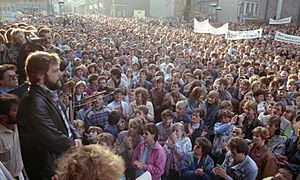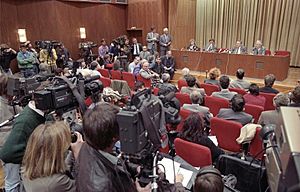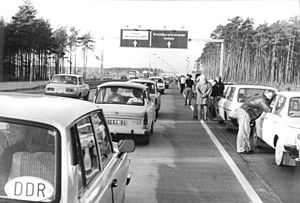Wende facts for kids
The Wende (pronounced "VEN-duh") means "the turn-around" in German. It describes a big change in East Germany (also known as the German Democratic Republic or GDR) during 1989 and 1990. This happened after the Soviet Union started making reforms under Mikhail Gorbachev.
During the Wende, the communist party, called the Socialist Unity Party of Germany (SED), lost its power. A new government was then set up, which was democratic. The decisions made by this new government eventually led to German reunification in October 1990.
The Wende was very peaceful. People who were against the SED and communism did not use violence. Because of this, these events are also known as the Peaceful Revolution (in German: Friedliche Revolution).
Contents
How the Changes Began
The events of the Wende were part of a larger movement. Communism was falling apart across Eastern Europe. This included countries like Poland, Hungary, and Czechoslovakia. Soon, these countries started making big reforms.
In August 1989, Hungary opened its borders to Austria. Many tourists from East Germany used this chance. They crossed the border and escaped to Western countries.
By September, East Germans were no longer allowed to go to Hungary. So, more and more East Germans went to the embassies of West Germany in Warsaw and especially in Prague. Soon, over 4,000 people were waiting at the Prague embassy. West Germany worked to get East Germany to let its people go.
On September 30, 1989, the West German Foreign Minister, Hans-Dietrich Genscher, came to Prague. He told the East Germans in the embassy garden that they could leave. They traveled to West Germany by trains that went through the GDR. In the first days of October, even more East Germans left Prague for West Germany.
Monday Protests in Leipzig
Inside East Germany, some groups formed to oppose the government. Examples include Neues Forum ("New Forum") and Demokratischer Aufbruch ("Democratic Awakening").
Starting in October 1989, many demonstrations took place. People protested against the SED and asked for democracy and human rights. In the city of Leipzig, people met every Monday at a church called Nikolaikirche. They prayed for peace and freedom. After praying, they would go out and protest. These protests became known as Montagsdemonstrationen ("Monday Demonstrations").
On October 7, 1989, East Germany celebrated its 40th "birthday." The SED held big parties in East Berlin and other cities. But at the same time, many people protested in the streets. More than 1,000 of them were arrested. In Plauen, in southern East Germany, many people also gathered for a protest.
Two days later, on October 9, the next Monday Demonstration happened in Leipzig. About 70,000 people walked peacefully through the city center. The police and the State Security (Stasi) did not try to stop them.
On October 18, the main leaders of the SED decided that their chairman, Erich Honecker, had to resign. Egon Krenz became the new leader of the SED. He also became the head of state. Krenz said he wanted to start a "Wende." But the protesters still wanted the SED to give up all its power.
The Berlin Wall Falls
On November 4, a very large protest happened at the Alexanderplatz in East Berlin. More than 400,000 people took part. The protest was even shown live on East German television.
The East German government was discussing a new rule about traveling to West Germany and other countries. On the evening of November 9, 1989, there was a press conference. Günter Schabowski, a spokesman for the SED, led it. Just before the conference, Egon Krenz had given Schabowski a paper about the new travel rule.
Before the press conference ended, a journalist asked Schabowski about freedom of travel. Schabowski read from his paper. It said that everyone should be allowed to leave the country and come back whenever they wanted. When asked when this rule would start, Schabowski answered "at once" and "immediately."
Many people watched this press conference on TV. West German news also reported that East Germany would open its borders "immediately." So, more and more East Germans went to the Berlin Wall to see if it was true. When they saw the Wall was still closed, they became very angry.
After 11:00 PM, the border opened at one border checkpoint called Bornholmer Straße. Soon, other checkpoints also opened. That night, many people went to West Berlin and then came back. In the following days and weeks, thousands of people visited West Germany.
"Round Tables" and the End of the Stasi
On November 13, 1989, Hans Modrow became the new leader of East Germany. He set up a Round Table for making political decisions. This Round Table included members from the SED, opposition groups, and churches. Many other Round Tables were also set up in cities and towns.
Many people in East Germany still feared the Ministry of State Security, known as the "Stasi." This was the secret police. Modrow renamed the Ministry to Amt für Nationale Sicherheit ("Office of National Security"; AfN). The AfN started destroying the documents they had collected over the years.
The opposition groups wanted these documents to be saved. So, they took over all the Stasi offices across the country in December 1989 and January 1990. The last office they took over was the Stasi headquarters in East Berlin on January 15, 1990.
Free Elections
On March 18, 1990, there were free elections for the East German parliament, called the Volkskammer ("People's Chamber"). These elections were won by the Allianz für Deutschland ("Alliance for Germany"). This was a group of parties that wanted East Germany to join West Germany.
The most important party in the Alliance was the CDU. Their chairman, Lothar de Maizière, became the new leader of East Germany. The new government began the process of reunification. This process finally ended on October 3, 1990, when Germany became one country again.




